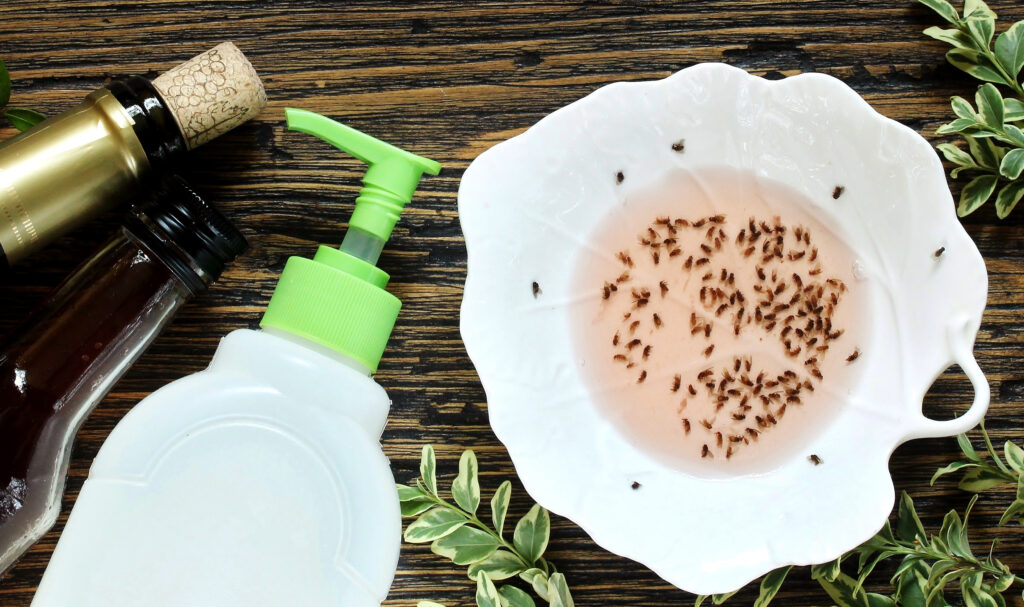10 Effective Ways to Get Rid of Gnats in Your House

Gnats are common household pests that can quickly become a nuisance. These tiny flying insects multiply at an alarming rate—adult females can lay up to 300 eggs in their short 10-day lifespan—making prompt action essential to prevent larger infestations.
Identifying their breeding sources and implementing effective control methods can help you reclaim your home from these persistent insects, while simple preventative measures can keep them from returning once eliminated.
Table of Contents
- Understanding Gnats: What Are They?
- What Attracts Gnats to Your Home?
- 1. Identify Where the Gnats Are Coming From
- 2. Use Apple Cider Vinegar and Dish Soap Traps
- 3. Try Sticky Traps for Plants and Windows
- 4. Clean Out Sink Drains
- 5. Take Out Garbage Frequently
- 6. Dry Out Houseplants
- 7. Replace or Cover Fruit and Food Left Out
- 8. Use a Chemical or Natural Gnat Spray
- 9. Seal Entry Points Around Doors and Windows
- 10. Call a Pest Control Professional (If Needed)
- How to Prevent Gnats from Returning
- Additional Home Improvement Resources
Understanding Gnats: What Are They?
Gnats are small, winged insects typically found in groups and known for hovering in place. They’re commonly seen in kitchens, around houseplants, or in damp environments. Identifying which type has entered your home is the first step toward effective treatment.
Common Types of Gnats
There are three main types of gnats you might encounter:
- Fungus gnats: Black with long legs, typically found near overwatered houseplants.
- Fruit flies: Brown with red eyes and usually more round in shape, commonly hovering over ripe fruit or vegetables.
- Drain flies: Fuzzy with moth-like wings, typically congregating around drains, sewers, or septic tanks.
While most indoor gnats don’t bite or spread disease, they’re still unwelcome guests that should be addressed before their numbers increase.
What Attracts Gnats to Your Home?
Gnats are drawn to moisture and food sources, making kitchens and bathrooms common areas for infestations. Understanding what attracts them helps with both prevention and elimination:
- Sweet and fruity scents
- Water and moisture
- Body heat
- Fruits, vegetables, and flowers
- Food residue in sinks
Getting rid of gnats is straightforward with the right approach and consistent effort. Let’s explore ten effective methods to eliminate these insects and keep your home gnat-free.
1. Identify Where the Gnats Are Coming From
Before you can effectively tackle a gnat problem, you need to identify the source of the infestation. Different types of gnats are attracted to different environments:
- Fungus gnats have black bodies with long legs and typically hover around houseplants with moist soil
- Fruit flies are brown with red eyes and gather around ripening fruits and vegetables
- Drain flies have fuzzy, moth-like wings and congregate near drains and sewers
Take a few minutes to observe where gnats are most concentrated in your home. “Finding and eliminating these sites is critical for reducing gnat populations,” says Diana Ludwiczak, a certified home pest inspector. Common breeding grounds include overwatered plants, trash cans, sink drains, and fruit bowls.
2. Use Apple Cider Vinegar and Dish Soap Traps
One of the most effective and budget-friendly solutions for gnat control is the apple cider vinegar trap. This DIY method works because gnats are attracted to the sweet smell of vinegar but can’t escape once they make contact with the liquid.
Here’s how to make this simple trap:
- Pour apple cider vinegar into a bowl or jar
- Add a few drops of dish soap (this breaks the surface tension, causing gnats to sink)
- For extra effectiveness, cover with plastic wrap and poke small holes in the top
Place these traps in areas where you’ve noticed gnat activity – near houseplants, fruit bowls, or kitchen counters. The sweet aroma will lure gnats in, and the soap will ensure they don’t make it back out.
3. Try Sticky Traps for Plants and Windows
For fungus gnats that plague your houseplants, sticky traps are incredibly effective. These traps utilize bright colors (typically yellow) to attract gnats, then capture them on an adhesive surface.
Position sticky traps directly in the soil of infested plants or hang them near windows where gnats tend to gather. For maximum effectiveness, place traps at plant level, as gnats typically fly close to soil surfaces. Replace the traps once they become covered with insects.
Commercial sticky traps are available at most garden centers, or you can make your own using yellow cards coated with a thin layer of petroleum jelly.
4. Clean Out Sink Drains
Kitchen and bathroom drains provide the perfect breeding ground for gnats, especially drain flies. These pests thrive in the organic matter that builds up in pipes, feeding on the bacteria and decaying material.
To eliminate drain-dwelling gnats:
- Pour ½ cup of salt and ½ cup of baking soda down the drain
- Follow with 1 cup of white vinegar and allow it to foam for at least two hours
- Finish by flushing with boiling water
For regular maintenance, periodically scrub inside drains with a long-handled brush to remove the organic matter that clings to pipe walls. Keeping drains clean breaks the gnat lifecycle by eliminating the food source for their larvae.
5. Take Out Garbage Frequently
Rotting food in garbage cans creates an ideal breeding ground for gnats. To minimize this attraction:
- Empty kitchen trash daily, especially when it contains fruit scraps or other food waste
- Use garbage cans with tight-fitting lids that seal completely
- Rinse food containers before tossing them in the trash
- Keep outdoor garbage bins and compost piles at least 15 feet away from your home
“Keeping surfaces clean and dry will help reduce breeding grounds for gnats,” notes Ludwiczak. This simple habit of proper waste management can significantly reduce gnat populations in your home.
6. Dry Out Houseplants
Overwatered houseplants create the perfect environment for fungus gnats, which feed on the fungi that grow in damp soil. If your plants have become a gnat nursery, it’s time to adjust your watering routine.
Allow the top two inches of soil to dry completely between waterings. This drying period kills gnat eggs and larvae while preventing the growth of the fungi they feed on. Your plants might wilt slightly during this process, but most will recover once you resume normal watering.
For persistent infestations, consider repotting plants with fresh soil. You can also add a layer of sand or fine gravel on top of the soil to deter gnats from laying eggs.
7. Replace or Cover Fruit and Food Left Out
That bowl of fresh fruit on your counter might look appealing to you—but it’s also irresistible to gnats. Ripening fruits release ethylene gas and sweet aromas that attract these pests from surprising distances.
To reduce this attraction:
- Store ripe fruit in the refrigerator rather than on countertops
- Keep fruit in sealed containers or under covers when left out
- Wash produce immediately after purchase to remove any gnat eggs
- Dispose of overripe or rotting produce promptly
Remember that even small food particles can sustain a gnat population, so be diligent about wiping down counters and sweeping floors after meals.
8. Use a Chemical or Natural Gnat Spray
When DIY methods aren’t enough, consider using a specialized gnat spray. For indoor use, look for products that are labeled safe for homes with children and pets.
Natural alternatives include:
- Neem oil spray: Mix 2 teaspoons of neem oil with 1 teaspoon of mild liquid soap and 1 quart of water
- Hydrogen peroxide solution: Mix 1 part 3% hydrogen peroxide with 4 parts water and use to water plants (this kills gnat larvae in the soil)
- Essential oil sprays: Combine water with a few drops of lemongrass, peppermint, or tea tree oil
Apply these solutions directly to gnat-infested areas, following package directions for commercial products. Remember that most sprays target adult gnats, so you’ll need to reapply as new gnats emerge from eggs.
9. Seal Entry Points Around Doors and Windows
Gnats can enter your home through the tiniest cracks and openings. Inspect your home’s exterior and seal any potential entry points:
- Repair tears in window and door screens
- Apply weatherstripping around doors and windows
- Seal cracks in your home’s foundation and exterior walls
- Caulk gaps around pipes and utility lines
This preventive measure not only helps with gnat control but also improves your home’s energy efficiency and keeps out other pests.
10. Call a Pest Control Professional (If Needed)
If you’ve tried multiple methods without success, or if the infestation is severe, it might be time to call in the professionals. Pest control experts can:
- Accurately identify the specific type of gnat
- Locate hidden breeding sources you might have missed
- Apply professional-grade treatments safely
- Provide guidance on preventing future infestations
While most gnat problems can be resolved with DIY methods, persistent infestations might indicate a larger issue that requires professional attention.
How to Prevent Gnats from Returning
Once you’ve successfully eliminated gnats, take these steps to keep them from returning:
- Control humidity: Run a dehumidifier to keep indoor humidity below 55%, which makes your home less hospitable to gnats
- Inspect plants before bringing them home: Check for signs of pests before introducing new plants to your indoor environment
- Clean drains regularly: Maintain clean drains by flushing them weekly with hot water
- Practice proper food storage: Develop consistent habits for storing and disposing of food
- Use yellow bug light bulbs outdoors: Replace outdoor lighting with yellow bulbs that are less attractive to gnats and other flying insects
Conclusion
Getting rid of gnats requires a combination of targeted methods and preventive strategies. These small bugs can be dealt with if you stick to the right steps. You should see fewer gnats within days when you use the methods outlined in this article.
Try using more than one method at once for better results. Set up vinegar traps while also fixing drain problems and changing how you water plants. This works better because it tackles gnats in all their hiding spots.
Keeping gnats away is just as important as getting rid of them. Clean your drains often, store food properly, and take care of plants the right way. This makes your home less likely to attract gnats.
Start using these simple methods today to keep your home free of gnats all year long.
Additional Home Improvement Resources
- Trending Wallpaper in 2025
- How to Clean Your Dryer Vent
- Essential Home Maintenance Tasks for Every Season

Anna has over six years of experience in the home services and journalism industries and serves as the Content Manager at MyHomePros.com, specializing in making complex home improvement topics like HVAC, roofing, and plumbing accessible to all. With a bachelor’s degree in journalism from Auburn University, she excels in crafting localized, comprehensive guides that cater to homeowners’ unique needs. Living on both coasts of the United States has equipped her with a distinctive perspective, fueling her passion for turning any house into a cherished home through informed, personalized decision-making.






